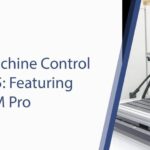The integration of Machine Learning (ML) and Artificial Intelligence (AI) into CNC (Computer Numerical Control) machine tools marks a significant evolution in the manufacturing industry.
This blog explores how these advanced technologies are transforming CNC machining, enhancing productivity, and paving the way for smarter manufacturing processes.
Understanding CNC Machine Tools
CNC machines are automated milling devices that produce industrial components without direct human assistance.
They utilize coded instructions sent to an internal computer, enabling precise control over various machining tools. These machines are pivotal in industries such as automotive, aerospace, medical, and more.
The Role of AI and ML in CNC Machining
AI and ML have emerged as transformative forces in CNC machining.
These technologies optimize processes, predict outcomes, and enhance efficiency. Here’s a closer look at their applications:
1. Predictive Maintenance
One of the most crucial aspects of CNC machining is minimizing downtime.
AI and ML algorithms analyze data from machine sensors to predict when a machine component might fail.
This predictive maintenance approach ensures timely interventions, reducing unexpected breakdowns and enhancing machine longevity.
Detailed Insight: Predictive Maintenance
Predictive maintenance leverages ML models to predict potential machine failures before they occur.
Sensors placed on CNC machines collect data on temperature, vibration, and other critical parameters.
This data is then analyzed to identify patterns that precede equipment failure.
- Data Collection: Sensors gather real-time data from various parts of the machine.
- Data Analysis: ML algorithms analyze the collected data to identify patterns and anomalies.
- Prediction: The system predicts when a machine component is likely to fail, allowing for preemptive maintenance.
Benefits:
- Reduced Downtime: By predicting failures before they happen, manufacturers can schedule maintenance during non-operational hours.
- Cost Savings: Preventive maintenance is generally less costly than emergency repairs.
- Increased Machine Longevity: Regular maintenance based on accurate predictions extends the lifespan of CNC machines.

2. Tool Wear Prediction
Tool wear is a significant concern in CNC machining. ML models, particularly neural networks, can predict tool wear by analyzing parameters such as cutting forces and vibration signals.
This capability helps in scheduling timely tool changes, thereby reducing costs and improving machining accuracy.
3. Optimization of Machining Parameters
Optimizing machining parameters is essential for achieving high precision and efficiency.
ML algorithms analyze historical data to determine the best settings for different materials and cutting conditions.
This optimization leads to better surface finishes, higher productivity, and reduced energy consumption.
4. Energy Consumption Prediction
Reducing energy consumption is not only cost-effective but also environmentally friendly.
AI models predict energy usage patterns, enabling manufacturers to implement energy-saving measures.
This approach aligns with sustainable manufacturing practices, reducing the carbon footprint of CNC operations.
5. Surface Quality Prediction
Surface quality is a critical metric in manufacturing.
ML techniques can predict the surface finish of machined parts, ensuring that the final product meets stringent quality standards.
This prediction is based on various factors, including tool condition, material properties, and machining parameters.
In-Depth Focus: Optimization of Machining Parameters
Understanding Machining Parameter Optimization:
Machining parameters such as spindle speed, feed rate, and depth of cut are crucial for the efficiency and quality of the machining process.
The traditional approach involves manual adjustments based on operator experience, which can be time-consuming and less precise.
Role of AI and ML:
AI and ML revolutionize this process by analyzing vast amounts of data to determine the optimal parameters automatically.
This data-driven approach ensures that the machining process is efficient and produces high-quality parts consistently.
Process Overview:
- Data Collection: Sensors on CNC machines collect data on current machining operations.
- Data Processing: The collected data is processed using ML algorithms to identify patterns and correlations.
- Optimization: Based on the analysis, the system suggests optimal machining parameters for different operations and materials.
Case Study: Surface Finish Improvement
In a case study involving the machining of titanium alloys, ML algorithms were used to optimize the cutting parameters.
The results showed a significant improvement in surface finish and a reduction in tool wear.
Steps Involved:
- Initial Data Collection: Data on surface finish and tool wear was collected from initial machining runs.
- ML Model Training: The data was used to train an ML model to predict the impact of different parameters on surface finish.
- Parameter Adjustment: The model suggested optimal parameters that minimized tool wear and maximized surface finish quality.
- Implementation and Testing: The suggested parameters were implemented, and the results were validated through testing.
Benefits:
- Enhanced Surface Quality: The optimized parameters resulted in a smoother surface finish, meeting the required specifications.
- Extended Tool Life: Reduced tool wear led to lower maintenance costs and longer tool life.
- Increased Efficiency: The machining process became faster and more efficient, reducing production time and costs.

Benefits of AI and ML in CNC Machining
- Increased Efficiency: Automated optimization and predictive maintenance reduce downtime and enhance operational efficiency.
- Cost Savings: Predictive tool wear and energy consumption models help in reducing operational costs.
- Improved Quality: Enhanced surface quality prediction ensures high standards in finished products.
- Sustainability: Energy-saving measures contribute to greener manufacturing processes.
Conclusion
The fusion of AI and ML with CNC machine tools is revolutionizing the manufacturing industry.
These technologies not only enhance efficiency and productivity but also pave the way for sustainable and smart manufacturing solutions.
As research progresses, we can expect even more innovative applications that will continue to push the boundaries of what’s possible in CNC machining.
Stay tuned for more insights into how cutting-edge technologies are transforming industries and driving progress.
References
Soori, M., Arezoo, B., & Dastres, R. (2023). Machine learning and artificial intelligence in CNC machine tools, A review. Sustainable Manufacturing and Service Economics, 2(2023), 100009.








